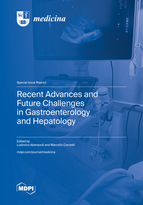Recent Advances and Future Challenges in Gastroenterology and Hepatology
A special issue of Medicina (ISSN 1648-9144). This special issue belongs to the section "Gastroenterology & Hepatology".
Deadline for manuscript submissions: closed (10 July 2023) | Viewed by 44544
Special Issue Editors
Interests: nonalcoholic fatty liver disease; alcoholic liver disease; gut microbiota; Mediterranean diet; nutrition; COVID-19; probiotic
Special Issues, Collections and Topics in MDPI journals
Interests: sepsis; gastrointestinal bleeding; pancreatitis; infection; COVID-19; head trauma; Helicobacter pylori infection; coeliac disease; breath tests for liver function; IBD; microbiota
Special Issues, Collections and Topics in MDPI journals
Special Issue Information
Dear Colleagues,
Gastroenterology and hepatology are fields of research that have improved significantly in recent decades in terms of clinical approach, diagnosis, and therapy. However, many issues remain to be clarified and explored, with many questions unanswered. For example, basic science, including translational and clinical discoveries, supported by technological innovations such as artificial intelligence, will enable further steps toward better, more refined care for many digestive diseases. Further innovations will help physicians to improve clinical practice, to define new guidelines, and to enable personalized care and treatment based on patient characteristics.
The aim of this Special Issue is to highlight recent advances and future challenges in gastroenterology and hepatology.
We solicit research papers, short reports, reviews, systematic reviews, meta-analyses, letters to the editor, and commentary papers.
Dr. Ludovico Abenavoli
Dr. Marcello Candelli
Guest Editors
Manuscript Submission Information
Manuscripts should be submitted online at www.mdpi.com by registering and logging in to this website. Once you are registered, click here to go to the submission form. Manuscripts can be submitted until the deadline. All submissions that pass pre-check are peer-reviewed. Accepted papers will be published continuously in the journal (as soon as accepted) and will be listed together on the special issue website. Research articles, review articles as well as short communications are invited. For planned papers, a title and short abstract (about 100 words) can be sent to the Editorial Office for announcement on this website.
Submitted manuscripts should not have been published previously, nor be under consideration for publication elsewhere (except conference proceedings papers). All manuscripts are thoroughly refereed through a single-blind peer-review process. A guide for authors and other relevant information for submission of manuscripts is available on the Instructions for Authors page. Medicina is an international peer-reviewed open access monthly journal published by MDPI.
Please visit the Instructions for Authors page before submitting a manuscript. The Article Processing Charge (APC) for publication in this open access journal is 1800 CHF (Swiss Francs). Submitted papers should be well formatted and use good English. Authors may use MDPI's English editing service prior to publication or during author revisions.
Keywords
- liver disease
- research
- gastrointestinal tract
- nutrition
- pancreatic disease
- diagnosis
- treatment
- artificial intelligence








